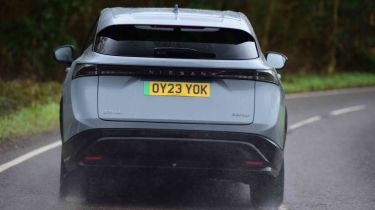Nissan Ariya - Range, charging and running costs
If range is important, then upgrade to the Ariya 87kWh model, which offers over 300 miles from a charge

The Nissan Ariya presents buyers with a choice of two battery sizes, 63kWh and 87kWh. That means the official WLTP combined driving range is between 247 and 329 miles, depending on the model chosen. Higher specification cars, particularly those with e-4orce all-wheel drive, are heavier and bring a reduction in range, while the same is true of the Nismo models with extra power.
As the Ariya is an electric car, both company car tax and VED road tax are very reasonable compared to hybrid and petrol alternatives. Insurance costs are on the high side, but there’s not a huge difference in cost between the entry-level cars and the higher spec ones.
Electric range, battery life and charge time
Opting for the entry-level Nissan Ariya 63kWh Engage model means the overall range is a claimed 250 miles. Moving up to the 87kWh version with the Advance trim level sees an increase in range to 329 miles, while Nissan states that the 302bhp dual-motor e-4ORCE variant can cover up to 319 miles. All of these range figures are slightly reduced if you upgrade to the Evolve specification, which brings additional equipment and extra weight to the car. The even hotter Nismo variant, meanwhile, drops the range further to 261 miles.
Used - available now

2024 Nissan
Ariya
16,295 milesAutomaticElectric
Cash £24,000
2024 Nissan
Ariya
15,233 milesAutomaticElectric
Cash £29,000
2024 Nissan
Ariya
18,494 milesAutomaticElectric
Cash £27,995
2024 Nissan
Ariya
11,950 milesAutomaticElectric
Cash £26,000An energy-efficient heat pump is provided as standard. This helps preserve the vehicle's range by more efficiently heating the interior in cold weather. It’s useful for longer trips during winter months and something reserved for the options list of rivals like the Skoda Enyaq and Volkswagen ID.4.
With the Ariya capable of charging at up to 130kW, it should take around half an hour or so to complete an 80 per cent top-up of either battery size. We’d like overall efficiency to be a little better, however: the Ariya 63kWh Advance managed 3.7 miles per kW/h during our test, but other EVs, such as the Genesis GV60 and Skoda Enyaq can record in excess of four miles per kWh. Our test of the 87kWh e-4ORCE model saw returns in the region of 3.0m/KWh, getting up to 3.2m/kWh on longer runs.
If you decide the all-electric Ariya is the right family car for you, you’ll want to organise a good home charging set-up. Fully replenishing the 63kWh battery in base model Ariyas will take 10 hours from a 7.4kW home wallbox, while those with the larger 87kWh battery will need to be plugged in for roughly 14 hours.
|
Model |
Battery size |
Range |
Insurance group |
|
Nissan Ariya Engage FWD |
63kWh |
250 |
31A |
|
Nissan Ariya Engage FWD |
87kWh |
329 |
33A |
|
Nissan Ariya Advance AWD |
87kWh |
319 |
41A |
|
Nissan Ariya 87kWh AWD Nismo |
87kWh |
261 |
41A |
Tax
For now, zero-emission cars, regardless of list price, are in the UK's free road tax (VED) band, saving Ariya drivers a few hundred quid a year. From 2025, however, electric car owners in the UK will have to pay road taxes and the London Congestion Charge. Company car drivers will also enjoy the Benefit-in-Kind (BiK) savings that the full-electric Ariya attracts, which promises big savings compared to an equivalent petrol, diesel or hybrid family SUV.
Insurance groups
Getting insurance for the Ariya won’t be cheap compared with a regular petrol or diesel family SUV, because even the entry-level 63kWh Engage model sits in group 31 (out of 50). Go for the larger 87kWh battery and it’s group 33, while choosing an e-4orce 4x4 variant will see the insurance group jump to 41. The high-performance Nismo variant also sits in group 41.
The Ariya’s insurance groups are also on the high side compared to EV rivals with the entry-level Hyundai Ioniq 5 Premium in group 36, while the Skoda Enyaq starts as low as group 24.
Depreciation
The Ariya is predicted to retain between 40 and 46 per cent of its original value after a typical three-year/36,000-mile ownership period. The entry-level Engage models hold their value best, with the e-4orce 4x4 cars losing most.
That’s a similar retained value performance to the Hyundai Ioniq 5, which retains around 43 to 47 per cent, although not quite as good as the Skoda Enyaq, which should retain between 50 and 57 per cent over the same period.
To get an accurate valuation for a specific model, check out our valuation tool...








